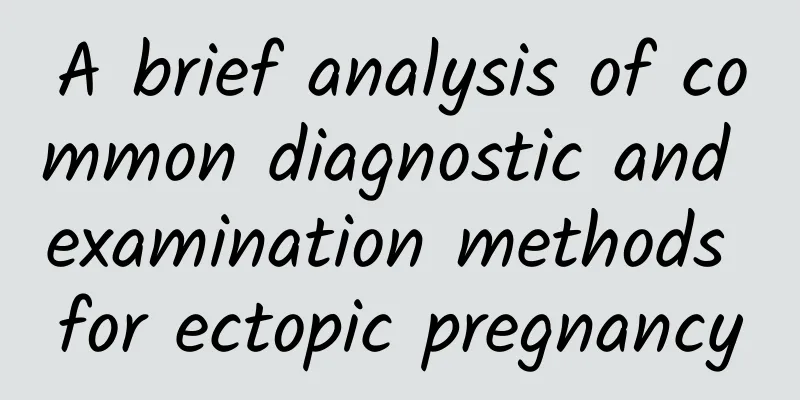A brief analysis of common diagnostic and examination methods for ectopic pregnancy

|
Ectopic pregnancy is a gynecological disease that seriously endangers women's health. Early detection of ectopic pregnancy is the key to treating ectopic pregnancy . What are the diagnostic examination methods for ectopic pregnancy? The following will tell you about the common diagnostic examination methods for ectopic pregnancy. In general, the common diagnostic tests for ectopic pregnancy are: 1. HCG determination. It is an important method for early diagnosis of ectopic pregnancy. 2. Progesterone measurement. The serum P level of ectopic pregnancy is low, but it is relatively stable at 5 to 10 weeks of pregnancy. A single measurement has a great diagnostic value. Although there is overlap between normal and abnormal pregnancy serum P levels, it is difficult to determine the absolute critical value between them, but serum P levels lower than 10ng/m1 (radioimmunoassay) often indicate abnormal pregnancy, and its accuracy rate is about 90%. 3. Ultrasound diagnosis. Type B ultrasound examination is particularly commonly used for the diagnosis of ectopic pregnancy, and vaginal B ultrasound examination is more accurate than abdominal B ultrasound examination. 4. Diagnostic curettage. When ectopic pregnancy cannot be ruled out, diagnostic curettage can be performed to obtain the endometrium for pathological examination. However, the endometrial changes in ectopic pregnancy are not characteristic and can be manifested as decidual tissue, highly secretory phase with or without A-S reaction, secretory phase and proliferative phase. Endometrial changes are related to whether the patient has vaginal bleeding and the duration of vaginal bleeding. Therefore, the diagnosis of ectopic pregnancy by diagnostic curettage alone has great limitations. 5. Posterior fornix puncture. Posterior fornix puncture is widely used to assist in the diagnosis of ectopic pregnancy. Blood can often be drawn out and placed without coagulation, and there are small clots in it. If no liquid is drawn out, the diagnosis of ectopic pregnancy cannot be ruled out. 6. Laparoscopic examination. In most cases, early ectopic pregnancy can be diagnosed after medical history, gynecological examination, blood β-HCG measurement, and B-ultrasound examination. However, for some cases that are difficult to diagnose, examination under direct laparoscope can confirm the diagnosis in time and can be treated surgically at the same time. The above is an introduction to the diagnostic examination methods for ectopic pregnancy. I hope it will be helpful to you. If you have any questions, you can contact our online experts, who will give you detailed answers. For more information, please visit the ectopic pregnancy disease special topic at http://www..com.cn/fuke/gwy/ or consult an expert for free. The expert will then give a detailed answer based on the patient's specific situation. |
<<: Experts answer questions about how to deal with dysmenorrhea
>>: Experts teach you how to correctly understand ectopic pregnancy
Recommend
What is the cause of mild cervicitis and what to do
Mild cervicitis is mostly caused by ascending inf...
Can eating Pueraria root help breast enlargement? Be careful of causing menstrual disorders
Which woman doesn't want to have a proud bust...
How to do ovarian cystectomy and what to do after surgery
How is ovarian cyst removal performed? 1. Ovarian...
Can I eat if I have abnormal leucorrhea?
Abnormal vaginal discharge is usually related to ...
Ovarian cysts are common
Ovarian cysts are a gynecological disease that ma...
For children with attention deficit hyperactivity disorder, depression, research shows that taking omega-3 and taking medication will have a greater effect!
To fight against COVID-19, recent studies have fo...
Several common methods of treating pelvic inflammatory disease
With the advancement of social science and techno...
What medicine is more effective for cervicitis and endometritis?
For cervicitis and endometritis, appropriate medi...
What are the abnormal symptoms after uterine fibroid surgery?
Uterine fibroids are the most common gynecologica...
What causes pain in the lower left side of the abdomen?
When women experience pain in the left lower abdo...
What should women pay attention to in their diet after abortion? Nine dietary precautions after abortion
After a woman has undergone an abortion, the scho...
What are the symptoms of cervical erosion?
What are the symptoms of cervical erosion? Cervic...
Experts introduce several precautions for vulvar leukoplakia
Understanding the precautions of vulvar leukoplak...
What to do if you have ectopic pregnancy or ovarian pregnancy
Ectopic pregnancy Ovarian pregnancy requires imme...
Experts describe the causes of vaginitis
Vaginitis is a common gynecological disease in wo...









